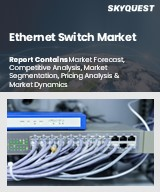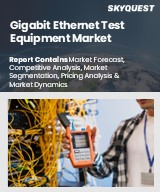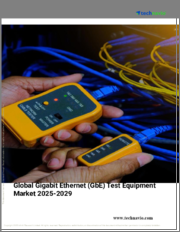
|
시장보고서
상품코드
1609044
세계의 메트로 이더넷 시장 : 유형별, 서비스별, 네트워크 유형별, 대역폭별, 용도별, 최종 사용자별 예측(2025-2030년)Metro Ethernet Market by Type, Service (Ethernet LAN Service, Ethernet Line Service, Ethernet Tree Service ), Network Type, Bandwidth, Application, End-User - Global Forecast 2025-2030 |
||||||
메트로 이더넷 시장의 2023년 시장 규모는 299억 1,000만 달러, 2024년에는 320억 3,000만 달러에 달할 것으로 예측되며, CAGR 4.89%로 성장하고, 2030년에는 417억 9,000만 달러에 달한다고 예측됩니다.
메트로 이더넷은 이더넷 기술을 사용하여 대도시 지역의 다양한 근거리 통신망(LAN)을 연결하고 빠르고 비용 효율적인 광대역 연결을 제공합니다. 이 기술은 서비스 제공업체의 네트워크에서 데이터, 비디오 및 음성을 전송하는 중요한 백본 역할을 합니다. 메트로 이더넷의 필요성은 클라우드 서비스, 빅데이터 분석, 통신 요구, 엔터프라이즈 연결을 지원하는 안정적이고 확장 가능한 네트워크 솔루션에 대한 수요 증가로 인해 발생합니다. 그 용도는 IT 및 통신, 교육, 헬스케어, 은행 등의 업계 및 유연한 대역폭 옵션과 합리화된 네트워크 관리를 제공합니다. 최종 사용자는 정부 기관, 중소기업 및 강력한 네트워킹 솔루션을 요구하는 대기업을 포함합니다.
| 주요 시장 통계 | |
|---|---|
| 기준년(2023) | 299억 1,000만 달러 |
| 추정년(2024) | 320억 3,000만 달러 |
| 예측년(2030) | 417억 9,000만 달러 |
| CAGR(%) | 4.89% |
이 시장은 인터넷 보급률의 상승, 디지털 기업으로의 이행, 클라우드 서비스의 채용 증가 등의 요인으로부터 큰 영향을 받고 있으며, 효율적이고 비용 효율적인 네트워킹 솔루션에 대한 수요가 높아지고 있습니다. 또한 보안 강화와 기존 네트워크 인프라와의 호환성 향상 등 이더넷 기술의 혁신은 시장 성장을 선호합니다. 최근의 동향은 광섬유 네트워크를 통한 메트로 이더넷의 제공이 확대될 가능성을 지적하고 있으며 공급자에게 새로운 수익원을 제공합니다.
그러나 시장 성장은 높은 초기 도입 비용, 복잡한 경쟁 환경, MPLS 및 SD-WAN과 같은 대체 기술과의 치열한 경쟁의 형태로 한계에 직면하고 있습니다. 과제는 서비스의 신뢰성을 유지하고 기존 시스템과 원활하게 통합하는 것입니다. 기술 혁신과 연구에 가장 적합한 분야는 네트워크 민첩성을 높이는 SDN(Software-Defined Networking) 솔루션 개발과 에지 컴퓨팅 용도에 맞는 광대역 서비스 기회를 찾는 것입니다. 기업은 특히 디지털 인프라의 요구가 커지고 있는 미개척 지역에서 서비스 제공 범위를 확대하기 위한 전략적 파트너십과 협업에 주력함으로써 이들을 활용할 수 있습니다. 시장 역학은 역동적이고 경쟁이 치열하며 기술의 발전과 시장 요구의 변화에 대응하기 위한 지속적인 혁신이 요구됩니다.
시장 역학: 빠르게 진화하는 메트로 이더넷 시장의 주요 시장 인사이트 공개
메트로 이더넷 시장은 수요 및 공급의 역동적인 상호작용에 의해 변모를 이루고 있습니다. 그리고 새로운 비즈니스 기회를 얻는 데 도움이 될 수 있습니다. 이러한 동향을 종합적으로 파악함으로써 기업은 정치적, 지리적, 기술적, 사회적, 경제적인 영역에 걸친 다양한 리스크를 경감할 수 있음과 동시에 소비자 행동과 그것이 제조 비용과 구매 동향에 미치는 영향을 보다 명확하게 이해할 수 있습니다.
- 시장 성장 촉진요인
- 접속성 향상과 인터넷 보급을 위한 인프라 정비의 진전
- 클라우드 서비스의 채용 확대와 데이터센터의 대량 보급
- 대규모의 확장성, 단순성, 매력적인 경제성을 실현하는 SDN(Software-Defined Networking)의 등장
- 시장 성장 억제요인
- 지연, 낮은 업로드 속도, 높은 패킷 손실
- 시장 기회
- 고가용성, 고속 복구 시간, 저지연을 보장하는 서비스 레벨 계약(SLA)을 제공하는 데이터 연결의 진보
- 데이터 교환과 통신을 강화하기 위한 기업이나 정부 기관의 데이터에 대한 의식의 고조
- 시장의 과제
- 레거시 배포와의 인터워킹
Porter's Five Force : 메트로 이더넷 시장을 탐색하는 전략 도구
Porter's Five Force Framework는 메트로 이더넷 시장 경쟁 구도를 이해하는 중요한 도구입니다. 프레임워크는 기업이 시장 내 세력도를 평가하고 신규 사업의 수익성을 판단하는 데 도움이 됩니다. 피할 수 있으며 더 강인한 시장에서 포지셔닝을 보장 할 수 있습니다.
PESTLE 분석 : 메트로 이더넷 시장에서 외부 영향을 파악
외부 거시 환경 요인은 메트로 이더넷 시장의 성과 역학을 형성하는 데 매우 중요한 역할을합니다. PESTLE 요인을 조사하면 기업은 잠재적인 위험과 기회를 더 잘 이해할 수 있습니다.
시장 점유율 분석 : 메트로 이더넷 시장 경쟁 구도 파악
메트로 이더넷 시장의 상세한 시장 점유율 분석을 통해 공급업체의 성과를 종합적으로 평가할 수 있습니다. 이 분석은 시장 집중, 단편화 및 통합 동향을 명확히하고 벤더는 경쟁이 치열 해짐에 따라 자사의 지위를 높이는 전략적 의사 결정을 내리는 데 필요합니다. 지식을 얻을 수 있습니다.
FPNV 포지셔닝 매트릭스 : 메트로 이더넷 시장에서 공급업체의 성능 평가
FPNV 포지셔닝 매트릭스는 메트로 이더넷 시장에서 벤더를 평가하는 중요한 도구입니다. 기본 결정을 내릴 수 있습니다. 네 가지 사분면을 통해 벤더를 명확하고 정확하게 분할하고 전략 목표에 가장 적합한 파트너 및 솔루션을 파악할 수 있습니다.
전략 분석 및 권장 : 메트로 이더넷 시장에서 성공에 대한 길을 그립니다.
메트로 이더넷 시장의 전략 분석은 세계 시장에서의 현장 강화를 목표로 하는 기업에 필수적인 요소입니다. 이러한 접근 방식을 통해 경쟁 구도에서 과제를 극복하고 새로운 비즈니스 기회를 활용하여 장기적인 성공을 거둘 수 있는 체제를 구축할 수 있습니다.
이 보고서는 주요 관심 분야를 포괄하는 시장의 종합적인 분석을 제공합니다.
1. 시장 침투: 현재 시장 환경의 상세한 검토, 주요 기업의 광범위한 데이터, 시장 도달범위 및 전반적인 영향력 평가.
2. 시장 개척도: 신흥 시장의 성장 기회를 파악하고 기존 분야의 확장 가능성을 평가하며 미래 성장을 위한 전략적 로드맵을 제공합니다.
3. 시장 다양화: 최근 제품 출시, 미개척 지역, 업계의 주요 진보, 시장을 형성하는 전략적 투자를 분석합니다.
4. 경쟁 평가 및 정보 : 경쟁 구도를 철저히 분석하여 시장 점유율, 사업 전략, 제품 포트폴리오, 인증, 규제 당국 승인, 특허 동향, 주요 기업의 기술 진보 등을 검증합니다.
5. 제품 개발 및 혁신 : 미래 시장 성장을 가속할 것으로 예상되는 최첨단 기술, R&D 활동, 제품 혁신을 강조합니다.
또한 이해관계자가 충분한 정보를 얻고 의사결정을 할 수 있도록 중요한 질문에 대답하고 있습니다.
1. 현재 시장 규모와 향후 성장 예측은?
2. 최고의 투자 기회를 제공하는 제품, 부문 및 지역은 어디입니까?
3. 시장을 형성하는 주요 기술 동향과 규제의 영향은?
4. 주요 벤더의 시장 점유율과 경쟁 포지션은?
5. 벤더 시장 진입·철수 전략의 원동력이 되는 수익원과 전략적 기회는 무엇인가?
목차
제1장 서문
제2장 조사 방법
제3장 주요 요약
제4장 시장 개요
제5장 시장 인사이트
- 시장 역학
- 성장 촉진요인
- 접속성과 인터넷의 보급률 향상을 위한 인프라 정비의 진전
- 클라우드 서비스의 도입 증가와 데이터센터의 대규모 보급
- 대규모의 확장성, 단순성, 그리고 매력적인 경제성을 실현하는 소프트웨어 정의 네트워크(SDN)의 등장
- 억제요인
- 지연, 업로드 속도가 낮고 패킷 손실이 많음
- 기회
- 데이터 연결의 진보는 고가용성, 고속 복구 시간, 낮은 지연 문제를 보장하는 보증된 서비스 수준 계약(SLA)을 제공합니다.
- 기업이나 정부기관간에 데이터에 대한 의식이 높아지고, 데이터 교환과 커뮤니케이션이 강화된다
- 과제
- 종래의 배치와의 제휴
- 성장 촉진요인
- 시장 세분화 분석
- Porter's Five Forces 분석
- PESTEL 분석
- 정치적
- 경제
- 사교
- 기술적
- 법률상
- 환경
제6장 메트로 이더넷 시장 : 유형별
- 이더넷 스위치
- 멀티 서비스 프로비저닝 플랫폼
- 라우터
제7장 메트로 이더넷 시장 : 서비스별
- 이더넷 LAN 서비스(E-LAN)
- 이더넷 회선 서비스(E-Line)
- 이더넷 트리 서비스(E-Tree)
제8장 메트로 이더넷 시장 : 네트워크 유형별
- 멀티 포인트 투 멀티 포인트
- 포인트 투 포인트
제9장 메트로 이더넷 시장 : 대역폭별
- 1Gbps
- 10Gbps
- 100Gbps
제10장 메트로 이더넷 시장 : 용도별
- 비즈니스 서비스
- 모바일 백홀
- 네트워크 인프라
제11장 메트로 이더넷 시장 : 최종 사용자별
- 기업
- 정부
- 통신
제12장 아메리카의 메트로 이더넷 시장
- 아르헨티나
- 브라질
- 캐나다
- 멕시코
- 미국
제13장 아시아태평양의 메트로 이더넷 시장
- 호주
- 중국
- 인도
- 인도네시아
- 일본
- 말레이시아
- 필리핀
- 싱가포르
- 한국
- 대만
- 태국
- 베트남
제14장 유럽·중동 및 아프리카의 메트로 이더넷 시장
- 덴마크
- 이집트
- 핀란드
- 프랑스
- 독일
- 이스라엘
- 이탈리아
- 네덜란드
- 나이지리아
- 노르웨이
- 폴란드
- 카타르
- 러시아
- 사우디아라비아
- 남아프리카
- 스페인
- 스웨덴
- 스위스
- 터키
- 아랍에미리트(UAE)
- 영국
제15장 경쟁 구도
- 시장 점유율 분석 2023
- FPNV 포지셔닝 매트릭스, 2023
- 경쟁 시나리오 분석
- 전략 분석과 제안
기업 목록
- Amdocs Limited
- AT&T Inc.
- British Telecommunications PLC
- BT Global Services Ltd.
- CenturyLink, Inc.
- China Telecom Corporation Limited
- Cisco Systems, Inc.
- Cogent Communications Holdings, Inc.
- Colt Technology Services Group Ltd.
- Comcast Corporation
- Consolidated Communications, Inc.
- Deutsche Telekom AG
- FiberLight, LLC
- Liberty Global
- Lumos Networks Corp.
- MetroNet Inc.
- Netcracker Technology Corporation
- NTT Communications Corporation
- Orange SA
- Tata Communications Ltd.
- Telefonaktiebolaget LM Ericsson
- Telstra Corporation Limited
- Verizon Communications Inc.
- Windstream Holdings, Inc.
- Zayo Group Holdings, Inc.
The Metro Ethernet Market was valued at USD 29.91 billion in 2023, expected to reach USD 32.03 billion in 2024, and is projected to grow at a CAGR of 4.89%, to USD 41.79 billion by 2030.
Metro Ethernet refers to using Ethernet technologies to connect various local area networks (LANs) within a metropolitan area, providing high-speed and cost-effective broadband connectivity. This technology serves as a crucial backbone for transmitting data, video, and voice over service provider networks. The necessity of Metro Ethernet arises from the growing demand for reliable and scalable network solutions to support cloud services, big data analytics, telecommunication needs, and enterprise connectivity. Its application spans industries such as IT and telecommunications, education, healthcare, banking, and more, offering flexible bandwidth options and streamlined network management. End-use scope includes government institutions, small-medium enterprises, and large corporations seeking robust networking solutions.
| KEY MARKET STATISTICS | |
|---|---|
| Base Year [2023] | USD 29.91 billion |
| Estimated Year [2024] | USD 32.03 billion |
| Forecast Year [2030] | USD 41.79 billion |
| CAGR (%) | 4.89% |
The market is significantly influenced by factors such as increasing internet penetration, the transition to digital enterprises, and the rising adoption of cloud services, which drive the demand for efficient and cost-effective networking solutions. Additionally, innovations in Ethernet technology, such as enhanced security and improved compatibility with existing network infrastructures, present lucrative opportunities for market growth. Recent trends point towards potential expansions in offering Metro Ethernet over optical fiber networks, opening new revenue streams for providers.
However, market growth faces limitations in the form of high initial deployment costs, complex regulatory environments, and fierce competition from alternative technologies like MPLS and SD-WAN. Challenges include maintaining service reliability and ensuring seamless integration with existing systems. The best areas for innovation and research lie in developing software-defined networking (SDN) solutions to enhance network agility and exploring opportunities in high-bandwidth services tailored for edge computing applications. Businesses can capitalize on these by focusing on strategic partnerships and collaborations to extend service reach, particularly in underserved regions with emerging digital infrastructure needs. The nature of the Metro Ethernet market is dynamic and competitive, requiring continuous innovation to adapt to technological advancements and changing market demands.
Market Dynamics: Unveiling Key Market Insights in the Rapidly Evolving Metro Ethernet Market
The Metro Ethernet Market is undergoing transformative changes driven by a dynamic interplay of supply and demand factors. Understanding these evolving market dynamics prepares business organizations to make informed investment decisions, refine strategic decisions, and seize new opportunities. By gaining a comprehensive view of these trends, business organizations can mitigate various risks across political, geographic, technical, social, and economic domains while also gaining a clearer understanding of consumer behavior and its impact on manufacturing costs and purchasing trends.
- Market Drivers
- Rising infrastructural development for enhanced connectivity and internet penetration
- Increased adoption of cloud services and massive penetration of the data centers
- Emergence of Software-Defined Networking (SDN) for massive scalability, simplicity, and compelling economics
- Market Restraints
- Latency, low upload speeds, and high packet loss
- Market Opportunities
- Advancement in data connectivity offering guaranteed service level agreements (SLAs) ensuring high availability, fast recovery times, and low latency issues
- Increased awareness among businesses, government organizations data for enhanced data exchange and communication
- Market Challenges
- Interworking with legacy deployments
Porter's Five Forces: A Strategic Tool for Navigating the Metro Ethernet Market
Porter's five forces framework is a critical tool for understanding the competitive landscape of the Metro Ethernet Market. It offers business organizations with a clear methodology for evaluating their competitive positioning and exploring strategic opportunities. This framework helps businesses assess the power dynamics within the market and determine the profitability of new ventures. With these insights, business organizations can leverage their strengths, address weaknesses, and avoid potential challenges, ensuring a more resilient market positioning.
PESTLE Analysis: Navigating External Influences in the Metro Ethernet Market
External macro-environmental factors play a pivotal role in shaping the performance dynamics of the Metro Ethernet Market. Political, Economic, Social, Technological, Legal, and Environmental factors analysis provides the necessary information to navigate these influences. By examining PESTLE factors, businesses can better understand potential risks and opportunities. This analysis enables business organizations to anticipate changes in regulations, consumer preferences, and economic trends, ensuring they are prepared to make proactive, forward-thinking decisions.
Market Share Analysis: Understanding the Competitive Landscape in the Metro Ethernet Market
A detailed market share analysis in the Metro Ethernet Market provides a comprehensive assessment of vendors' performance. Companies can identify their competitive positioning by comparing key metrics, including revenue, customer base, and growth rates. This analysis highlights market concentration, fragmentation, and trends in consolidation, offering vendors the insights required to make strategic decisions that enhance their position in an increasingly competitive landscape.
FPNV Positioning Matrix: Evaluating Vendors' Performance in the Metro Ethernet Market
The Forefront, Pathfinder, Niche, Vital (FPNV) Positioning Matrix is a critical tool for evaluating vendors within the Metro Ethernet Market. This matrix enables business organizations to make well-informed decisions that align with their goals by assessing vendors based on their business strategy and product satisfaction. The four quadrants provide a clear and precise segmentation of vendors, helping users identify the right partners and solutions that best fit their strategic objectives.
Strategy Analysis & Recommendation: Charting a Path to Success in the Metro Ethernet Market
A strategic analysis of the Metro Ethernet Market is essential for businesses looking to strengthen their global market presence. By reviewing key resources, capabilities, and performance indicators, business organizations can identify growth opportunities and work toward improvement. This approach helps businesses navigate challenges in the competitive landscape and ensures they are well-positioned to capitalize on newer opportunities and drive long-term success.
Key Company Profiles
The report delves into recent significant developments in the Metro Ethernet Market, highlighting leading vendors and their innovative profiles. These include Amdocs Limited, AT&T Inc., British Telecommunications PLC, BT Global Services Ltd., CenturyLink, Inc., China Telecom Corporation Limited, Cisco Systems, Inc., Cogent Communications Holdings, Inc., Colt Technology Services Group Ltd., Comcast Corporation, Consolidated Communications, Inc., Deutsche Telekom AG, FiberLight, LLC, Liberty Global, Lumos Networks Corp., MetroNet Inc., Netcracker Technology Corporation, NTT Communications Corporation, Orange S.A., Tata Communications Ltd., Telefonaktiebolaget LM Ericsson, Telstra Corporation Limited, Verizon Communications Inc., Windstream Holdings, Inc., and Zayo Group Holdings, Inc..
Market Segmentation & Coverage
This research report categorizes the Metro Ethernet Market to forecast the revenues and analyze trends in each of the following sub-markets:
- Based on Type, market is studied across Ethernet Switch, Multiservice Provisioning Platform, and Router.
- Based on Service, market is studied across Ethernet LAN Service (E-LAN), Ethernet Line Service (E-Line), and Ethernet Tree Service (E-Tree).
- Based on Network Type, market is studied across Multipoint-to-Multipoint and Point-to-Point.
- Based on Bandwidth, market is studied across 1 Gbps, 10 Gbps, and 100 Gbps.
- Based on Application, market is studied across Business Services, Mobile Backhaul, and Network Infrastructure.
- Based on End-User, market is studied across Enterprises, Government, and Telecom.
- Based on Region, market is studied across Americas, Asia-Pacific, and Europe, Middle East & Africa. The Americas is further studied across Argentina, Brazil, Canada, Mexico, and United States. The United States is further studied across California, Florida, Illinois, New York, Ohio, Pennsylvania, and Texas. The Asia-Pacific is further studied across Australia, China, India, Indonesia, Japan, Malaysia, Philippines, Singapore, South Korea, Taiwan, Thailand, and Vietnam. The Europe, Middle East & Africa is further studied across Denmark, Egypt, Finland, France, Germany, Israel, Italy, Netherlands, Nigeria, Norway, Poland, Qatar, Russia, Saudi Arabia, South Africa, Spain, Sweden, Switzerland, Turkey, United Arab Emirates, and United Kingdom.
The report offers a comprehensive analysis of the market, covering key focus areas:
1. Market Penetration: A detailed review of the current market environment, including extensive data from top industry players, evaluating their market reach and overall influence.
2. Market Development: Identifies growth opportunities in emerging markets and assesses expansion potential in established sectors, providing a strategic roadmap for future growth.
3. Market Diversification: Analyzes recent product launches, untapped geographic regions, major industry advancements, and strategic investments reshaping the market.
4. Competitive Assessment & Intelligence: Provides a thorough analysis of the competitive landscape, examining market share, business strategies, product portfolios, certifications, regulatory approvals, patent trends, and technological advancements of key players.
5. Product Development & Innovation: Highlights cutting-edge technologies, R&D activities, and product innovations expected to drive future market growth.
The report also answers critical questions to aid stakeholders in making informed decisions:
1. What is the current market size, and what is the forecasted growth?
2. Which products, segments, and regions offer the best investment opportunities?
3. What are the key technology trends and regulatory influences shaping the market?
4. How do leading vendors rank in terms of market share and competitive positioning?
5. What revenue sources and strategic opportunities drive vendors' market entry or exit strategies?
Table of Contents
1. Preface
- 1.1. Objectives of the Study
- 1.2. Market Segmentation & Coverage
- 1.3. Years Considered for the Study
- 1.4. Currency & Pricing
- 1.5. Language
- 1.6. Stakeholders
2. Research Methodology
- 2.1. Define: Research Objective
- 2.2. Determine: Research Design
- 2.3. Prepare: Research Instrument
- 2.4. Collect: Data Source
- 2.5. Analyze: Data Interpretation
- 2.6. Formulate: Data Verification
- 2.7. Publish: Research Report
- 2.8. Repeat: Report Update
3. Executive Summary
4. Market Overview
5. Market Insights
- 5.1. Market Dynamics
- 5.1.1. Drivers
- 5.1.1.1. Rising infrastructural development for enhanced connectivity and internet penetration
- 5.1.1.2. Increased adoption of cloud services and massive penetration of the data centers
- 5.1.1.3. Emergence of Software-Defined Networking (SDN) for massive scalability, simplicity, and compelling economics
- 5.1.2. Restraints
- 5.1.2.1. Latency, low upload speeds, and high packet loss
- 5.1.3. Opportunities
- 5.1.3.1. Advancement in data connectivity offering guaranteed service level agreements (SLAs) ensuring high availability, fast recovery times, and low latency issues
- 5.1.3.2. Increased awareness among businesses, government organizations data for enhanced data exchange and communication
- 5.1.4. Challenges
- 5.1.4.1. Interworking with legacy deployments
- 5.1.1. Drivers
- 5.2. Market Segmentation Analysis
- 5.3. Porter's Five Forces Analysis
- 5.3.1. Threat of New Entrants
- 5.3.2. Threat of Substitutes
- 5.3.3. Bargaining Power of Customers
- 5.3.4. Bargaining Power of Suppliers
- 5.3.5. Industry Rivalry
- 5.4. PESTLE Analysis
- 5.4.1. Political
- 5.4.2. Economic
- 5.4.3. Social
- 5.4.4. Technological
- 5.4.5. Legal
- 5.4.6. Environmental
6. Metro Ethernet Market, by Type
- 6.1. Introduction
- 6.2. Ethernet Switch
- 6.3. Multiservice Provisioning Platform
- 6.4. Router
7. Metro Ethernet Market, by Service
- 7.1. Introduction
- 7.2. Ethernet LAN Service (E-LAN)
- 7.3. Ethernet Line Service (E-Line)
- 7.4. Ethernet Tree Service (E-Tree)
8. Metro Ethernet Market, by Network Type
- 8.1. Introduction
- 8.2. Multipoint-to-Multipoint
- 8.3. Point-to-Point
9. Metro Ethernet Market, by Bandwidth
- 9.1. Introduction
- 9.2. 1 Gbps
- 9.3. 10 Gbps
- 9.4. 100 Gbps
10. Metro Ethernet Market, by Application
- 10.1. Introduction
- 10.2. Business Services
- 10.3. Mobile Backhaul
- 10.4. Network Infrastructure
11. Metro Ethernet Market, by End-User
- 11.1. Introduction
- 11.2. Enterprises
- 11.3. Government
- 11.4. Telecom
12. Americas Metro Ethernet Market
- 12.1. Introduction
- 12.2. Argentina
- 12.3. Brazil
- 12.4. Canada
- 12.5. Mexico
- 12.6. United States
13. Asia-Pacific Metro Ethernet Market
- 13.1. Introduction
- 13.2. Australia
- 13.3. China
- 13.4. India
- 13.5. Indonesia
- 13.6. Japan
- 13.7. Malaysia
- 13.8. Philippines
- 13.9. Singapore
- 13.10. South Korea
- 13.11. Taiwan
- 13.12. Thailand
- 13.13. Vietnam
14. Europe, Middle East & Africa Metro Ethernet Market
- 14.1. Introduction
- 14.2. Denmark
- 14.3. Egypt
- 14.4. Finland
- 14.5. France
- 14.6. Germany
- 14.7. Israel
- 14.8. Italy
- 14.9. Netherlands
- 14.10. Nigeria
- 14.11. Norway
- 14.12. Poland
- 14.13. Qatar
- 14.14. Russia
- 14.15. Saudi Arabia
- 14.16. South Africa
- 14.17. Spain
- 14.18. Sweden
- 14.19. Switzerland
- 14.20. Turkey
- 14.21. United Arab Emirates
- 14.22. United Kingdom
15. Competitive Landscape
- 15.1. Market Share Analysis, 2023
- 15.2. FPNV Positioning Matrix, 2023
- 15.3. Competitive Scenario Analysis
- 15.4. Strategy Analysis & Recommendation
Companies Mentioned
- 1. Amdocs Limited
- 2. AT&T Inc.
- 3. British Telecommunications PLC
- 4. BT Global Services Ltd.
- 5. CenturyLink, Inc.
- 6. China Telecom Corporation Limited
- 7. Cisco Systems, Inc.
- 8. Cogent Communications Holdings, Inc.
- 9. Colt Technology Services Group Ltd.
- 10. Comcast Corporation
- 11. Consolidated Communications, Inc.
- 12. Deutsche Telekom AG
- 13. FiberLight, LLC
- 14. Liberty Global
- 15. Lumos Networks Corp.
- 16. MetroNet Inc.
- 17. Netcracker Technology Corporation
- 18. NTT Communications Corporation
- 19. Orange S.A.
- 20. Tata Communications Ltd.
- 21. Telefonaktiebolaget LM Ericsson
- 22. Telstra Corporation Limited
- 23. Verizon Communications Inc.
- 24. Windstream Holdings, Inc.
- 25. Zayo Group Holdings, Inc.



















